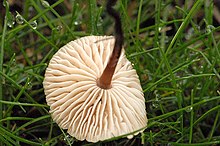Real garlic dizzy
| Real garlic dizzy | ||||||||||||
|---|---|---|---|---|---|---|---|---|---|---|---|---|

Common Garlic Duckster ( Mycetinis scorodonius ) |
||||||||||||
| Systematics | ||||||||||||
|
||||||||||||
| Scientific name | ||||||||||||
| Mycetinis scorodonius | ||||||||||||
| ( Fr .: Fr.) AW Wilson & Desjardin |
The real garlic dizziness ( Mycetinis scorodonius , syn. Marasmius scorodonius ), also called real mousseron or small garlic dizziness, is a species of fungus from the Omphalotaceae family that is sometimes very common in Central Europe.
features
Macroscopic features
The fruiting bodies appear distributed or "gregarious". The hat is usually 1 to 2, rarely up to 4 centimeters wide, spread out and often wrinkled. Its color is pale brown to buff. The rather distant, whitish lamellae are dry, curled up, are often cross-linked with veins at the base and are attached narrowly to the stem. The stem is tough and tubed. It is glabrous on the surface, shiny and red-brown in color, brown-black at the base and mostly paler at the top. It becomes 2 to 6 centimeters long and 0.5 to 3 millimeters thick and tapers towards the bottom. The pale, very thin and tough meat tastes mild and tastes and smells very intensely of garlic or onions. The spore powder appears white.
Microscopic features
The spores are ellipsoidal to narrow teardrop-shaped and measure 6 to 10 by 3 to 5 micrometers. Their surfaces are smooth. There are buckle connections in the fabric. Cystides are found on the edges of the lamellae (cheilocystids), but not on the sides of the lamellae (pleurocystids). The cheilocystids reach up to 40 by 11 micrometers and are cylindrical to club-shaped or irregularly shaped. The structure of the hat skin is similar to that of the fruit layer ( hymeniderm ).
Species delimitation
There are some similar species with a garlic odor, such as the string-handled garlic gnome ( Mycetinis alliaceus ) or Mycetinis copelandii and Mycentinis olidus . The string-handled garlic dodgy, which may be incompatible in larger quantities, produces fruit on dead beech wood. The North American species Mycetinis copelandii and Mycentinis olidus have velvety to hairy stems and longer spores. The needle dwarf dwarf ( Marasmiellus perforans ) differs by a dull black-brown stem and a different, unpleasant odor.
Distribution and ecology
The fungus is found in the eastern part of North America and Europe, among other places. The species lives as a secondary decomposer ( saprobiont ) on coniferous litter, wood residues or between grasses in coniferous forests and on forest meadows. The fruiting bodies appear from June to November, often very numerous after heavy rain. When dry, they can shrivel up and become plump again with moisture and recover.
meaning
The real garlic dwarf is edible. Especially in France it is a valued, productive herb mushroom . The fruit bodies can also be dried without losing the aroma.
Systematics and taxonomy
The official scientific first description of the species can be found under the name Agaricus scorodonius in the first volume of the "Observationes mycologicae" by Elias Magnus Fries , published in 1815 . The species epithet refers to the garlic taste of the fruiting bodies. He later classified them in the "Anteckningar öfver de i Sverige växande ätliga svampar" published in 1836 in the genus of swindlers ( Marasmius ). In an article published in 2005, the scientists Andrew W. Wilson and Dennis E. Desjardin separated the species from the swindles together with other garlic Marasmius species on the basis of genetic analyzes and used the generic name Mycetinis , introduced in 1909, again.
swell
literature
- Svengunnar Ryman, Ingmar Holmåsen: Mushrooms. Over 1,500 species of mushrooms are described in detail and photographed in their natural surroundings. Bernhard Thalacker, Braunschweig 1992, ISBN 3-87815-043-1 .
- Josef Breitenbach, Fred Kränzlin (Ed.): Mushrooms of Switzerland. Contribution to knowledge of the fungal flora in Switzerland. Volume 3: Bolete and agaric mushrooms. Part 1: Strobilomycetaceae and Boletaceae, Paxillaceae, Gomphidiaceae, Hygrophoraceae, Tricholomataceae, Polyporaceae (lamellar). Mykologia, Luzern 1991, ISBN 3-85604-030-7 .
Individual evidence
- ↑ Jadson JS Oliveira, Ruby Vargas-Isla, Tiara S. Cabral, Doriane P. Rodrigues, Noemia K. Ishikawa: Progress on the phylogeny of the Omphalotaceae: Gymnopus s. str., Marasmiellus s. str., Paragymnopus gen. nov. and Pusillomyces gen. nov. In: Mycological Progress . tape 18 , no. 5 , May 2019, ISSN 1617-416X , p. 713-739 , doi : 10.1007 / s11557-019-01483-5 .
- ^ A b Andrew W. Wilson, Dennis E. Desjardin: Phylogenetic relationships in the gymnopoid and marasmioid fungi (Basidiomycetes, euagarics clade) . In: Mycologia . tape 97 , 3, May / June, 2005, ISSN 0027-5514 , p. 667-679 , doi : 10.3852 / mycologia.97.3.667 , PMID 16392255 (English, mycologia.org [PDF]).
- ↑ a b c Michael Kuo: Mycetinis scorodonius. In: MushroomExpert.com website. January 2013, accessed May 20, 2013 .
- ↑ a b c Edmund Michael (founder), Bruno Hennig, Hanns Kreisel (ed.): Handbook for mushroom friends. Volume 1: Hanns Kreisel (Ed.): The most important and most common mushrooms with special consideration of the poison mushrooms. 5th, revised edition. Fischer, Stuttgart et al. 1983, ISBN 3-437-30436-4 , p. 270.
- ^ Andreas Gminder : Manual for mushroom collectors. Identify 340 species of Central Europe with certainty . Franckh-Kosmos Verlags-GmbH & Co. KG, Stuttgart 2008, ISBN 978-3-440-11472-8 , p. 152 .
- ^ A b Hans E. Laux: The great cosmos mushroom guide. All edible mushrooms with their poisonous doppelgangers . Franckh-Kosmos Verlags-GmbH & Co., Stuttgart 2010, ISBN 978-3-440-12408-6 .
- ^ Scott A. Gordon, Ronald H. Petersen: Infraspecific variation among geographically separated collections of "Marasmius scorodonius" . In: Mycotaxon . tape 69 , October / December, 1998, ISSN 0093-4666 , p. 453-466 (English, org.uk ).
- ^ Elias Magnus Fries : Observationes mycologicae. Volume 1. Bonnier, Copenhagen 1815, p. 29.
- ^ Elias Magnus Fries (Praeses): Anteckningar öfver de i Sverige växande ätliga svampar. Palmblad, Sebell, Upsala 1836, p. 53.
